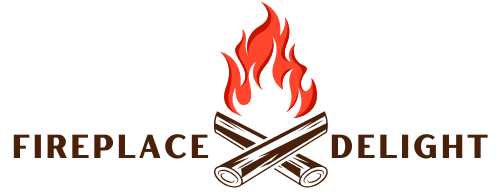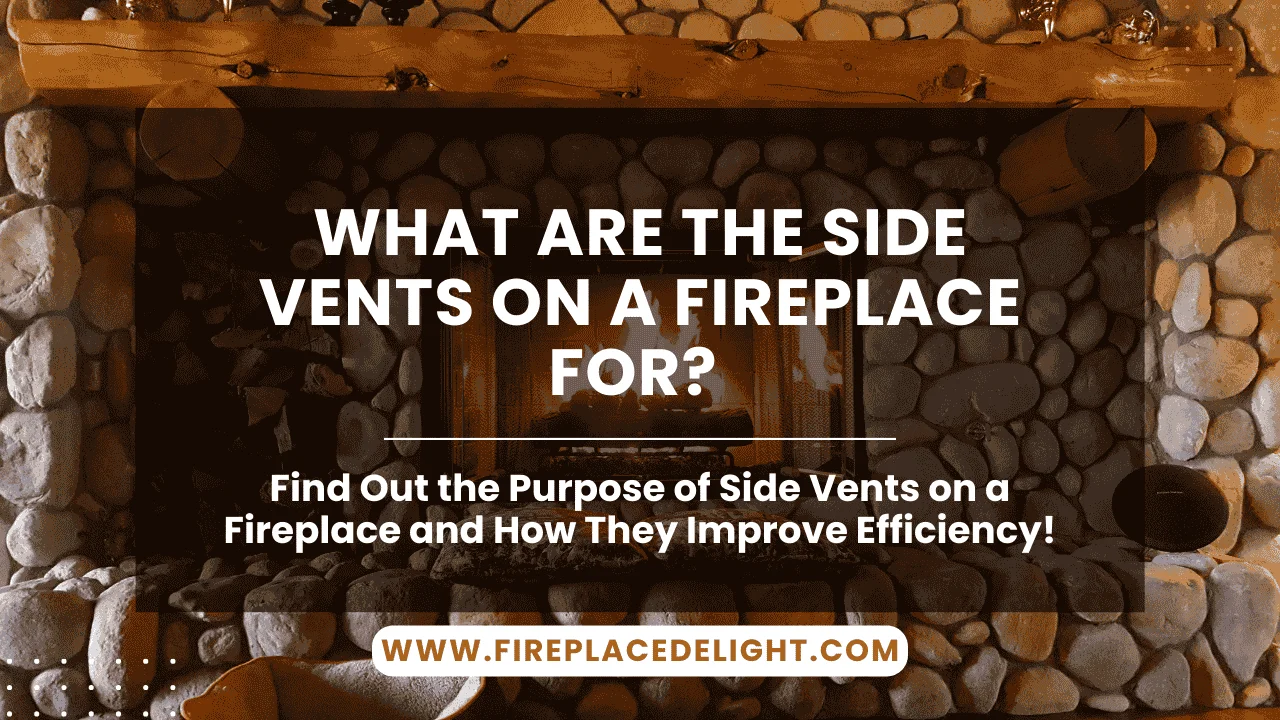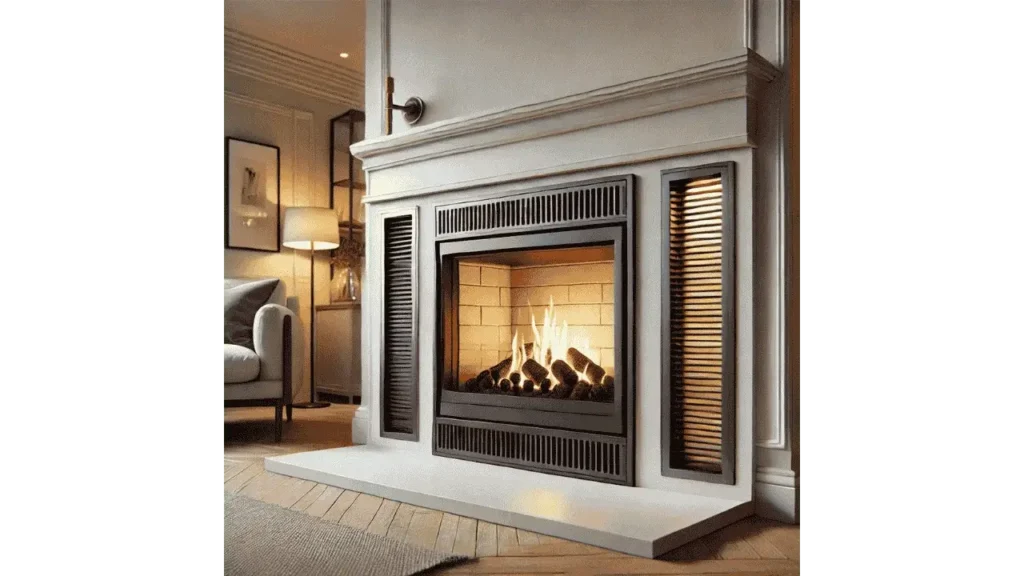When it comes to choosing the right fireplace for your home, understanding the different types of venting systems is crucial for both safety and efficiency. The vent type you choose impacts the performance of your fireplace, as well as the air quality and comfort in your home. Whether you’re considering a traditional wood-burning fireplace, a modern gas fireplace, or something more unique like a ventless model, knowing how each venting system works can help you make an informed decision.
In this guide, we’ll break down the most common fireplace vent types, including natural vents, direct vents, power vents, and ventless fireplaces, to help you understand their benefits, limitations, and suitability for different homes and needs.
Fireplace Vent Types Explained
When choosing a fireplace for your home, understanding the different vent types is crucial to ensuring efficient operation and safety. Fireplace vents play a key role in channeling exhaust gases, like smoke and carbon monoxide, out of your home. They also affect the overall performance of your fireplace. Below, we explore four common fireplace vent types, their advantages, and considerations to help you make the right decision for your space.
4 Fireplace Vent Types
Fireplaces can be vented in several ways, each with its own benefits and challenges. The most common venting methods include natural venting, direct venting, ventless, and power venting. Let’s dive deeper into the first two to better understand how they work.
Natural Vent: Commonly Called B-vent or Natural Draft
A natural vent, often referred to as a B-vent or natural draft system, is a traditional method of venting a fireplace. In this setup, the fireplace draws air from inside your home to fuel combustion, and the exhaust gases are expelled through a chimney or vent pipe to the outside. The natural upward flow of hot gases, assisted by the warmth of the fire, creates a draft that moves the smoke and carbon monoxide out of the home.
This type of venting is often found in older fireplaces and wood-burning stoves. One of its main advantages is that it doesn’t require a fan or additional mechanical assistance. However, the downside is that it can be less efficient compared to newer venting systems. Since it uses air from inside your home, there may be some air loss, and it is more prone to issues like downdrafts, especially in windy conditions. It’s essential to ensure the chimney is properly maintained and cleaned to avoid safety hazards.
Direct Vent: The Most Popular Fireplace Vent Type
The direct vent system is one of the most popular vent types, particularly for gas fireplaces. This type of venting system is a closed combustion system, meaning the fireplace draws air from outside your home for combustion and exhausts the gases back out through a sealed pipe. It uses two pipes, one for intake and one for exhaust, allowing it to operate efficiently without affecting the air quality inside the home.
Direct vent systems are highly efficient and safer compared to natural vent systems because they eliminate the need for the fireplace to rely on the air inside your home. This also means there is no risk of indoor air being lost, which helps maintain heating efficiency. Additionally, direct vent fireplaces don’t suffer from downdrafts or the common issues associated with traditional chimney systems. Since these systems are sealed and vented to the outdoors, they also reduce the risk of carbon monoxide entering your home.
In conclusion, the choice of fireplace vent depends on several factors, such as the type of fuel used, the layout of your home, and your heating preferences. While natural venting is ideal for older homes with existing chimneys, direct venting offers superior efficiency and safety, making it the most popular option for modern gas fireplaces. Understanding these vent types will help you select the best system for a safe and comfortable home.
Power Vent
A power vent is a type of forced ventilation system commonly used in modern fireplaces, especially in homes where a traditional chimney or direct vent system isn’t feasible. Power vents use an electric fan or blower to push exhaust gases out of the home through a vent pipe. This type of venting can be installed in locations that would otherwise be difficult to vent using natural or direct vent systems, such as homes without chimneys or in rooms where venting up through the roof isn’t possible.
The power vent offers greater flexibility when it comes to venting because it can push the exhaust gases horizontally through a wall, making it suitable for spaces where vertical venting is challenging. It also helps ensure a consistent draft, reducing the risk of downdrafts and improving the efficiency of the fireplace. However, since the system relies on electricity to function, it may not be ideal during power outages. Additionally, installation costs can be higher compared to traditional venting systems.
Vent Free: or Ventless Fireplaces
Ventless fireplaces, also known as vent-free fireplaces, have gained popularity for their ease of installation and ability to operate without an external vent or chimney. Unlike traditional vented fireplaces, ventless models burn fuel (such as gas) in a way that minimizes emissions, so they don’t require a chimney or vent system to expel exhaust gases. Instead, these fireplaces release the combustion byproducts, like carbon dioxide, directly into the room.
One of the key benefits of ventless fireplaces is their efficiency and convenience. Since no venting is required, they are easy to install, even in spaces where venting would be impractical, such as apartments or rooms without chimneys. They also tend to be more energy-efficient because all the heat produced by the fire stays in the room. However, it’s important to consider the air quality in your home when using a ventless fireplace. Although modern ventless fireplaces are designed to operate safely, they can deplete oxygen levels in a room over time, so it’s crucial to ensure proper ventilation and follow manufacturer guidelines for usage.
Why Don’t Ventless Fireplaces Require a Chimney?
Ventless fireplaces don’t require a chimney because they are designed to burn fuel in a highly efficient way that minimizes the production of harmful byproducts. Instead of releasing exhaust gases like carbon monoxide through a chimney, ventless fireplaces are engineered to produce fewer emissions, which can safely dissipate into the air inside the home.
The combustion process in ventless fireplaces is carefully controlled to ensure that the gases produced, like carbon dioxide, are at safe levels. Additionally, ventless systems use specialized burners and oxygen sensors to maintain optimal air quality and to prevent the buildup of dangerous gases. This makes ventless fireplaces ideal for smaller or well-ventilated spaces, where the need for a chimney or vent is eliminated. However, despite the lack of a chimney, it is still essential to monitor the room’s air quality and ensure adequate ventilation to prevent any safety concerns, particularly in tightly sealed or poorly ventilated rooms.
Overall, ventless fireplaces offer a convenient and energy-efficient heating option, but their usage requires careful consideration of air quality and proper room ventilation.
Conclusion
Choosing the right fireplace vent type is essential for ensuring optimal performance, safety, and comfort in your home. Whether you opt for a traditional natural vent, a more modern direct vent, a flexible power vent, or a ventless fireplace, each system has its own advantages and considerations. Natural vents offer a classic solution but can be less efficient, while direct vents provide a sealed and efficient option that prevents indoor air loss. Power vents offer versatility and convenience, especially for homes without chimneys, and ventless fireplaces provide ease of installation without the need for a chimney, although they require careful management of air quality. By understanding these venting systems and their unique features, you can make the best choice for your home’s heating needs while ensuring safety and efficiency for many years.
- 27 Farmhouse Fireplace Ideas That Bring Warmth & Charm - August 18, 2025
- 25 Fireplace Lighting Ideas to Illuminate Your Hearth - August 7, 2025
- How to Replace an Electric Fireplace Switch? - August 5, 2025



